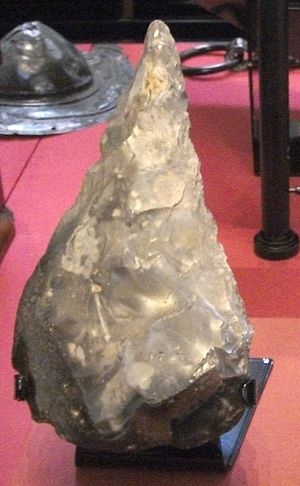| Gray's Inn Lane Hand Axe | |
|---|---|
 Pointed flint hand axe from Gray's Inn Lane, London Pointed flint hand axe from Gray's Inn Lane, London | |
| Size | 165 mm (6 in) long |
| Created | 350,000 years ago |
| Discovered | Gray's Inn Lane, London |
| Present location | British Museum, London |

The Gray's Inn Lane Hand Axe is a pointed flint hand axe, found buried in gravel under Gray's Inn Lane, London, England, by pioneering archaeologist John Conyers in 1679, and now in the British Museum. The hand axe is a fine example from about 350,000 years ago, in the Lower Paleolithic period, but its main significance lies in the role it and the circumstances of its excavation played in the emerging understanding of early human history.
Discovery and history
John Conyers was present at the excavation in 1679 of the remains of a supposed elephant at Battlebridge in gravel; the site was near Gray's Inn Lane, opposite "Black Mary's", and the remaining tooth was later thought to be of a mammoth or straight-tusked elephant. A pointed flint hand axe was found nearby,
At the time, it was commonly thought that humans had been on earth for a relatively short period of time, and that stone tools were used by people who simply lacked the knowledge to create metal tools.
Conyers was the first to argue that it was a human artefact. After Conyers' death, John Bagford (1650–1716) published the discovery, rejecting the idea that the assemblage of elephant bones and stone axe had originated from the time of Noah's flood, arguing instead for its origin in the Roman period under the Emperor Claudius; this was in a letter of 1715, in which Bagford accepted the human origin of the handaxe. With other items from Conyers' collection, the handaxe passed to the collection of Sir Hans Sloane, whose own collection was one of the founding collections of the British Museum.
According to the British Museum website, the hand axe is now estimated to be about 350,000 years old. Elephants were living in Britain at this time, during a period in the Ice age when the climate was similar to that of today. The hand axe is currently displayed in the "Enlightenment Gallery" of the British Museum, which is housed in the King's Library.
See also
- Saltley handaxe in Birmingham
References
- Joseph M. Levine (1977), Dr Woodward's Shield: History, Science and Satire in Augustan England
Notes
- ^ British Museum (2011). "British Museum – Pointed flint handaxe". britishmuseum.org. Retrieved 14 October 2011.
Gray's Inn Road, London, England This flint handaxe was found in gravel near the bones of an elephant by John Conyers in 1679.
- ^ Cockburn, J S; King, H P F; McDonnell, K J T (2011). "Archaeology – The Lower Palaeolithic Age | A History of the County of Middlesex: Volume 1 (pp. 11–21)". british-history.ac.uk. Retrieved 14 October 2011.
At the end of the century a Mr. Conyers found, opposite 'Black Mary's' near Gray's Inn Lane, a handaxe associated with the tooth of an elephant, (fn. 2) probably that of either a mammoth or the straight-tusked elephant (E. antiquus). John Bagford in a letter dated 1715 suggested that this elephant was probably introduced by Claudius, but at the same time accepted the implement as being of human workmanship.
- ^ Levine, p. 141.
- ^ British History Online
- Burnby, Juanita (2008). "Archive of Transactions: John Conyers, London's first archaeologist". lamas.org.uk. Archived from the original on 28 September 2011. Retrieved 14 October 2011.
- Burnby, Juanita. "Conyers, John". Oxford Dictionary of National Biography (online ed.). Oxford University Press. doi:10.1093/ref:odnb/56834. (Subscription or UK public library membership required.)
- J. Evans (1897). The ancient stone implements, weapons, and ornaments, of Great Britain. pp. 581–583. Retrieved 14 October 2011.
where an engraving of this hand-axe from Gray's Inn Lane is reproduced (fig. 451). It was first reported by John Bagford in Hearne's edition of Leland, Collectanea, i, p. lxiv.